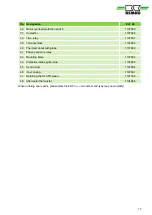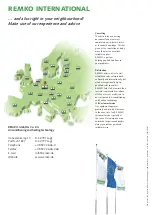
1.6 Safety instructions for the oper-
ator
The operational safety of the units and compo-
nents is only assured providing they are used as
intended and in a fully assembled state.
n
The personnel tasked with operating the units
must check the units for visible defects on the
operating and safety devices as well as the
presence and function of the protective devices
prior to starting work.
If defects are discovered these must be
reported to the supervisor!
n
In the event of defects that endanger the
operational safety of the unit, operation must
be discontinued immediately.
n
Do not operate units or components with
obvious defects or signs of damage.
n
Observe the respective local regulations and
the relevant electrical safety measures when
using the units.
n
Safety devices must not be bypassed or disa-
bled.
n
Maintain safety distances to combustible mate-
rials.
n
Never insert foreign objects into the units.
n
The units must not be covered during opera-
tion.
n
The units must not be operated in the vicinity of
bathtubs, showers, swimming pools etc.
n
The units must not be operated directly below
a wall socket.
n
The units and components must not be
exposed to any mechanical load, extreme
levels of humidity or extreme temperatures.
n
Never allow water to enter the units.
n
Protective covers (grilles) over moving parts
must not be removed from units that are in
operation.
n
Contact with equipment parts or components
can lead to burns or injury.
n
All housing parts and unit openings, e.g. air
inlets and outlets, must be free from foreign
objects.
n
The air outlet must not be constricted or
equipped with pipe or hose lines.
n
All electrical cables for the units must be pro-
tected against damage, including damage
caused by animals.
n
The units must be inspected by a service tech-
nician to ensure that they are safe to use and
fully functional at least once yearly. Visual
inspections and cleaning may be performed by
the operator when the units are disconnected
from the mains.
1.7 Safety notes for installation,
maintenance and
inspection work
n
The units and components may only be set up,
installed and maintained by qualified per-
sonnel.
n
Appropriate hazard prevention measures must
be taken to prevent risks to people when per-
forming installation, repair, maintenance or
cleaning work on the units.
n
The setup, connection and operation of the
units and its components must be undertaken
in accordance with the usage and operating
conditions stipulated in this manual and comply
with all applicable regional regulations.
n
Regional regulations and laws must be
observed.
n
The units must be installed and operated in
such a way that personnel are not endangered
by warm air and radiant heat and that no fires
can occur
n
A safety zone of 1.5 m should be maintained
around the units - including non-combustible
items
n
The power supply should be adapted to the
requirements of the units.
n
Mobile units must be set up securely on suit-
able non-combustible surfaces.
n
The units and components should not be oper-
ated in areas where there is an increased risk
of damage. Observe the minimum clearances.
n
The units and components must be kept at an
adequate distance from flammable, explosive,
combustible, abrasive and dirty areas.
n
The units must not be installed or operated in
atmospheres containing oil, sulphur or salt.
n
The units must not be exposed to direct jets of
water, e.g. pressure washers etc.
n
Safety devices must not be bypassed or disa-
bled.
1.8 Unauthorised modification
and changes
Modifications or changes to units and components
are not permitted and may cause malfunctions.
Safety devices may not be modified or bypassed.
Original replacement parts and accessories
authorised by the manufactured ensure safety. The
use of other parts may invalidate liability for
resulting consequences.
5
Содержание ELT 40
Страница 19: ......






































